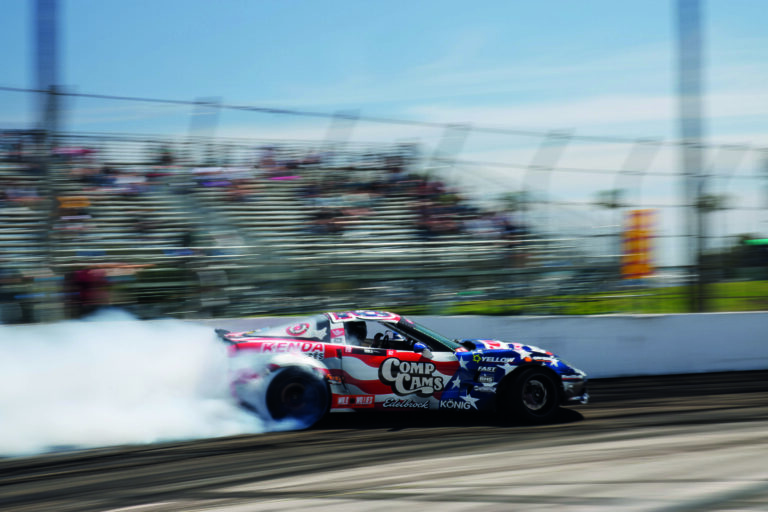Behind the spectacular plumes of smoke, there’s a lot of technological know-how in the development of tires used for drifting.
For the vast majority of tire applications, drifting is a less than desirable attribute. However, for professional drifting drivers, suitable tires are arguably the most important part of the sport. In the United States, Formula Drift has some of the most stringent regulations around the tires allowed in competition.
Unlike some motorsports, Formula Drift requires tires used in competition to be commercially available to the public. These tires must comply with the American Department of Transportation (DOT) regulations for street-legal tires, and Formula Drift rules state that tires should be marketed at no more than US$500 each. As a result, these tires are not drift specific; instead they are ultra-high-performance (UHP) tires with characteristics that make them suitable for drifting.
A drifting competition consists of two tandem battles. After qualifying to determine the starting order, each driver has a stint as a lead driver and as a chase driver. Judging is based on the driver’s line, angle and style throughout the course. The chase driver must mimic the lead driver’s line, angle, pace and transitions while staying in close proximity. The winning driver is the one who performs best in both positions.
A set of rear tires will generally last for just one round due to the extreme conditions experienced in such a short period of time. Professional drifting driver James Deane placed third in round six of this year’s Formula Drift competition and has been professionally drifting since the age of 15. For the last 10 years he has been a brand ambassador for Falken Tires and uses the Falken Azenis RT 615K with 295/40 R18s on the rear and, depending on the car, 235 to 265s on the front. With this tire he’s won three consecutive Formula Drift USA championships, multiple European Championships, several Irish Championships and three Championship competitions in the Middle East. He explains, “In competition, the rear tires last for around a minute of drifting.” To complete a round successfully, tires need to be robust, have adequate grip and perform consistently.
Aiming high
Although it might seem contradictory, tires used for drifting perform better with higher levels of grip. Drifting cars tend to have large, wide rear tires and smaller, narrower fronts. Weight placement throughout the vehicle is based on personal preference.
Within competition, the limit for tire width is dictated by the weight of the vehicle – for example, in the 2,100-2,399 lb (953-1,088kg) class, tires must not exceed 240mm wide. To reach the bounds of these regulations, drivers use extremely low tire pressures.
“I run as low as 6psi in the rear tires and 24psi cold in the front tires,” says Deane. This makes it difficult to propel the car forward without a lot of grip and an extremely powerful drivetrain. As such, professional drifting cars have upward of 1,000bhp to generate the power required to move the vehicle forward and laterally.
Carrying the weight of the vehicle and coping with those lateral forces – while operating under lower pressures than the tires are designed for – creates deflection, which can result in a tire debeading. Kenda Tires, a Formula Drift sponsor, supplies its Vezda UHP Max tire to four drivers competing in this season’s competition. The Vezda line is manufactured in Vietnam and is based on a product used for the Japanese Formula Drift series.
“We have to make sure we have a good, strong bead structure and a good, strong toe characteristic so that the tire will stay on the wheel,” explains Kenda vice president of engineering Tom Williams.
Although debeading is not a common occurrence in professional drifting, keeping the tire on the wheel is integral to ensuring all other aspects of the tire’s design can operate as intended.
Finding the right tire pressure is down to the driver and team, who must fine-tune the level of grip in direct correlation to the contact patch.
“Bridgestone was active in the drift scene back in the early 2000s with the Bridgestone Potenza RE-01R,” explains Will Robbins, director of consumer product strategy at Bridgestone Americas. “The Potenza RE-01R had a great balance of overall grip, controllability at high slip angles and wear performance that worked well for Formula D competition.”
The Potenza RE-01R’s successor, Potenza Race, is now favored by amateur drifters and trackday enthusiasts.
“Tires are designed to operate within a certain deflection envelope that is influenced externally by load and inflation pressure,” says Robbins. “Too much inflation pressure causes the tire footprint to lift the shoulders. Too little inflation pressure causes the footprint to go concave, lifts the tire’s center and causes the tire casing to over-deflect and roll. The correct pressure ensures an optimum footprint and casing support, maximizing grip, feedback and predictability.”
Once the driver has established their ideal contact patch, tread blocks are also key to successful drifting.
“There’s a lot of torque going into the tires as well as lateral forces, so you have to have some very big and stiff tread blocks,” explains David Poling, vice president of R&D and plant technical at Giti Tire North America. GT Radial, part of Giti Tire, is a sponsor of the Formula Drift competition and has a team of drivers who compete with the Champiro SX2 RS tire, manufactured at Giti Tires’ plant in South Carolina. This tire is based on an existing product and modified with specialized compounding and constructions to make it suitable as a high-performance, street-legal, motorsport tire. Large tread blocks maximize the amount of rubber on the track and are more likely to resist deformation.
In Bridgestone’s Potenza Race tire, says Ian McKenney, senior product manager at Bridgestone Americas, the angle at which these blocks sit is also important.
“The block wall angles are asymmetrical and slanted in to create more lateral cornering force,” he explains. “If they were completely vertical, then that block is more apt to fold over on itself.”
Although McKenney believes the angle of the tread blocks can make them more robust, Williams argues that the overall pattern of these blocks is less crucial: “It’s more a matter of how much void is in the tread design and how the design wears.”
Although the Kenda Vezda UHP Max tire has a directional symmetrical pattern, Williams believes the priority is to achieve a low-void design to maximize the amount of rubber in contact with the track surface.
However, in wet conditions, tread becomes more important for dispersing water, and higher tire pressures are required to enable the tread to do its job.
“We’ve added sipes in the inside portion of the tread to funnel the water away from the footprint,” says McKenney of the Potenza Race’s asymmetrical pattern.
Extreme conditions
In dry conditions, Poling argues that compounding can lead to the biggest performance differences: “The most important part is compounding – having a compound that can take the heat that’s generated and has good abrasion resistance.”
Poling estimates that tires operate at temperatures between 93°C and 121°C during a drift. To make a drift possible, Deane explains, “We might be drifting a corner at 80mph [129km/h] but the tires are doing 120mph [193km/h]. So, the rear tires are spinning so hard that the car is sliding.”
To better understand the balance of materials required to achieve the desired compound characteristics, Poling says GT Radial has learned from its racing experience at endurance events such as the Nürburgring 24 Hours.
“That’s another brutal test of your tires in terms of durability and endurance,” he explains. “In that scenario, it’s almost more important to make sure your tires are more durable, rather than having super-high lateral grip or anything like that, so there’s different levels of how you implement technology.”
In drifting, the compound must be able to cope with extreme heat for a short period of time. The key, says Williams, “is about high temperature and heat dissipation capabilities. A basic carbon black compound is going to be pretty good for drifting, as opposed to high silica or those types of materials that are used for low rolling resistance.” He notes that because the tires must be DOT approved, softer race compounds cannot be used.
“It’s not a high-silica compound,” Poling agrees. “It’s not something that you would normally see in a UHP tire that was trying to be a lot of things to a lot of people – this is all about raw, dry grip.”
However, Formula Drift regulations state that all tires must have a minimum tread wear rating of 200 UTQG (uniform tire quality grading).
“The 200 treadwear tire for drifting is probably too much grip for an amateur who’s running a lower-horsepower car,” says Williams. “It’s hard for the car to turn a very grippy tire and get the drifting characteristics they need. We have a 300 treadwear tire that is better for the amateur market – [those who are] out there drifting and having fun and don’t require as much horsepower to turn the tire.”
Beyond regulated aspects of tread wear, Deane notes the importance of consistent wear: “The Falken tire has the same level of grip from when it’s brand new to when it’s down to the wear markers.”
Robbins adds, “For performance tires, ensuring the tire footprint has even pressure distribution under extreme cornering can help the tire wear more evenly when used on track. This will reduce localized strain on parts of the tread pattern and reduce compound heat build-up, both of which are good for consistency.”
Considering the compound and structure of the tire, McKenney explains how the marriage of materials can be advantageous for grip as well as structural rigidity.
“The reinforcement or structure of the tire needs to be a little bit more robust. The construction for your caps and layers might not be the typical, let’s say, nylon that you would see in a passenger tire. Instead, [it’s] a hybrid of aramids and polyesters, and maybe some nylons, so that at temperature they have a higher tensile strength, but under loading they’re also able to keep their footprint shape on the track.”
“Aramid is key because it’s a high-tensile product and you don’t get as much deformation using rayon body plies,” Poling adds.
Combining all of these properties for mere minutes of drifting is an impressive showcase of the limits these tires can be taken to. Although DOT regulations curtail extensive alterations to create a perfect tire solely for drifting, Formula Drift is a huge marketing platform for tire manufacturers, offering an extreme – not to mention incredibly spectacular – way to demonstrate the capabilities of commercially available tire technologies.



